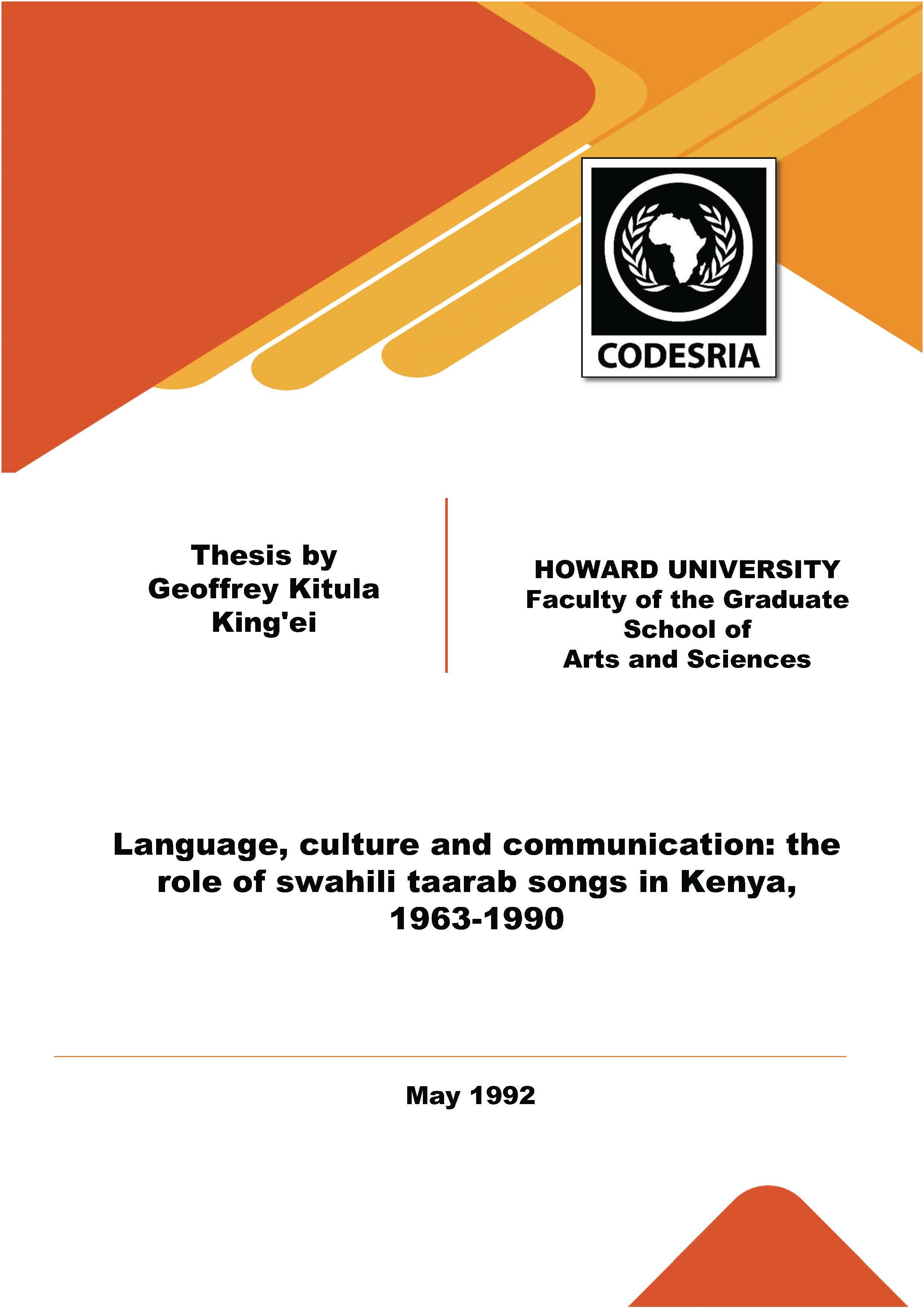Language, culture and communication: the role of swahili taarab songs in Kenya, 1963-1990
Keywords:
Languages, culture, communication, swahili language, oral tradition, taarab songs, KenyaSynopsis
This study explores the formai, thematic and socio-cultural attributes that have contributed to the molding of Swahili .llw:llb songs into a viable medium of sociopolitical communication in contemporary Kenya. The analysis is mainly descriptive and utilizes the sociopolitical and stylistic theoretical perspectives expounded by Terry Eagleton and Emmanuel N gara as well as insights from the speech-act theory outlined by Elizabeth Traugott and Mary Pratt . The corpus of the songs analyzed was collected during various field research trips between 1985-1991 and are composed by both male and female artists from Kenya's coastal city, Mombasa. The approaches used include both formai and informai interviews as well as the observer-participant method. The predominant themes conveyed through the songs and the stylistic attributes are discussed. The stùdy also critically examines the sociopolitical and cultural role played by Swahili Wlrllh in contemporary Kenya. The study concludes that although 1llilDU2 was borrowed into the Swahili culture from Arab and oriental cultures, its contemporary forrn and idiom is closely related to and draws from such forms as wjmbo, .slll!iri. n~njera and other traditional Swahili poetic forms. In addition, taarab provides a useful source of archaic Swahili vocabulary and an important avenue for mass communication. The study calls for the formulation of a national cultural policy that promotes the effective use and development of the tamh and other indigenous media of mass communication.
Downloads
References
Abedi, A. Sheria Za KuwnKa Mashairi Na Diwani Amri. Nairobi:East African Literature Bureau, 1954.
Abdalla A. "Tanzu 2.a Ushairi Wa Kiswahili:Historia Na Maendeleo" Unpublished Seminar Paper, University of Des Salaam, 1978.
Abdulaziz, Mohamed H. Muyaka;19th Cenruzy Swahili PoJ,ular poetzy. Nairobi: Kenya Literatu Bureau, 1979.
Achebe, C. Thjn s Fall Apan. London:Heineman, 1958.
. Momin Yet On Creation Day. London:Heinemann, 1975.
Akinyi, Beattie . "Sweet-Singing Malika Rocks the Music World". Kenya Times. (Nairobi, Feb. 16, 1992) , 10.
Allen. J. "Swahili History Re-visited". Unpublished Seminar Paper, Insitute of African Studies. University of Nairobi, November, 1976.
Anyidoho, K. (ed.) Inerdisplinary-DimensjonsofAfricanLireratur;e, (Washington, D.C: Three Continents Press, 1985), 89-99.
. "Swahilization: A Cultural Conceptand Its Significance in Kenya Today". Unpublished Seminar Paper. Institute of African Studies. University of Nairobi, November, 1979.
Nairobi:Heinemann, 1979 Armah, Ayi Kwei,"Masks and Marx", Presence Africaine. (Paris, No. 132), 34-67. Arnold, Reiner. "Swahili Literature in History: a Necessary Remark on Criticism", Kiswahili, vol. 42, no. 2, (Dares Salaam: Institute of Swahili Research, 1973), 69.
Austin John, L.,How to do Thin s With Words, Cambridge Mass: Harvard University Press, 1962: Bakari M. language and National Identity", Unpublished Seminar Paper.Institute of African Studies, University Of Nairobi, February, 1978.
Bascom, W. African Art in Culrural Perspective, New York: Nonon, 1973. Beier, U. Modem Poeny from Africa. Baltimore: Penguin, 1963
Bill, M.C. "The Structure andFunction of the Song in the Tsonga Folktale" African Studies (Vol. 42, No.l, February, 1983), 34-66.
Boyd, Allan. "The marl: A Musical Instrwnent in the Lamu Area, Kenya",Unpublished Seminar Paper, Institute of African Studies, University of Nairobi, Fe ary. 1977.
The Music of the Waswahili of Lamu, Kenya". Bulletin of Fotkwgys Records. New York: Folk..,ways Corporarion,1986.






